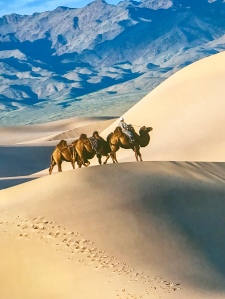
MARCO POLO in 1324 said about Mongolia:
“I DID NOT TELL YOU HALF OF WHAT I SAW, FOR NO ONE WOULD HAVE BELIEVED ME”

Chinggis Khaan, the founder of the Great Mongolia; he symbolizes Mongolia’s independence and national identity, playing an important role in shaping the history of Mongolia.
 For most of the 20th century Mongolia was isolated for the rest of the world and a sense of remoteness still exists today. Mongolia is the least densely populated country in the world. It’s is a pristine intact country, it’s the land of steppe, of blue skies, valleys full of flowers, mountain peaks hidden in the clouds.
For most of the 20th century Mongolia was isolated for the rest of the world and a sense of remoteness still exists today. Mongolia is the least densely populated country in the world. It’s is a pristine intact country, it’s the land of steppe, of blue skies, valleys full of flowers, mountain peaks hidden in the clouds.
 It’s a
It’s a place where dunes sing, where wild horses freely roam and where nomadic families hospitality has no limit and to understand how far it goes you have to live it personally.
place where dunes sing, where wild horses freely roam and where nomadic families hospitality has no limit and to understand how far it goes you have to live it personally. 
In Mongolia the four seasons have their own colors and peculiarities and astonishing geographical composition. At the east an endless steppa, in the south the Gobi desert with its bactrian camels wandering in the sand dunes, in the west the mountain peaks and glaciers fill the valleys, in the north are the most spectacular rivers and lakes, whilst at the centre the large valleys where the first Mongolian State started.




The Mongolia Ger deserves a special attention as it expresses the Mongolian concept of symbolism in harmony with nature. The word “GER” is Mongolian and literally means “Home”.
The Ger symbolizes the Mongolian people: no fences around their gers or they would lose their freedom, no stones or they could lose their connection to nature.
Traditionally ger are extremely mobile and can be set up and set down in a very short time, in more than 1 hour.
 The orientation of the Ger is symbolically important to Mongolians: entrance always faces south towards the sun, north is the most special place for sacred objects and visitors. West side is the male side where their tools, saddles and hunting kit are stored. East side is the female side where women sit and where cooking utensils are kept. Fireplace or stove is in the centre so smoke can exit through the crown of the roof which can be closed during bad weather conditions.
The orientation of the Ger is symbolically important to Mongolians: entrance always faces south towards the sun, north is the most special place for sacred objects and visitors. West side is the male side where their tools, saddles and hunting kit are stored. East side is the female side where women sit and where cooking utensils are kept. Fireplace or stove is in the centre so smoke can exit through the crown of the roof which can be closed during bad weather conditions.
The Gobi desert and flaming Cliffs — The Gobi desert has one of the most unusual desert landscapes with its spectacular singing dunes; this place made the Gobi desert famous all over the world. Bayanzag, a must see place, spreads across 8 km. in a valley, once was an ancient sea floor and site of several remarkable palentology sites. Wait for the sunset when the cliffs become of a breathtaking color with the red clay almost glowing.

Western Mongolia — Meet with the Kazakhs, eagle hunters in the Altai region, and experience their way of life while understanding how they hunt with their eagles.
The Kazakhs is Mongolia largest ethnic minority group living in the provinces of Western Mongolia. Hunting with eagles (called Berkutchi) is a form of falconry practiced here and almost all families are eagle hunters. Hunting takes place only in winter months and female eagles only are used.
 Hunting with eagles is a sense of identity. To western eyes the relationship may seem cruel or cold, but eagles are not considered as pets but working animals and Kazakhs hunters have an incredibly close connection with their eagles, they are virtually considered as family members, as for the other animals!
Hunting with eagles is a sense of identity. To western eyes the relationship may seem cruel or cold, but eagles are not considered as pets but working animals and Kazakhs hunters have an incredibly close connection with their eagles, they are virtually considered as family members, as for the other animals!

…… and when the night falls over the Mongolian countryside, the endless blue sky becomes a stage of bright stars: your personal light show to watch in a awe!!!!!
